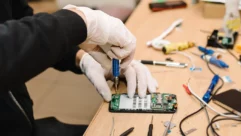The Right Mix: The applications of automatic microphone mixers are numerousand varied; know when and how to use them properly.
Jan 1, 1998 12:00 PM,
Dan Dugan
The application of automatic mixers in audio installations can beparticularly confusing because of the complexity of their operation. Thisarticle builds on the base of two previous S&VC automatic mixing tutorials:”The Theory Behind Automatic Mixers,” (March, 1994) and “What is this NOMthing, anyway?” (July, 1995). Readers interested in this field shouldreview both of those articles. In this article we’ll go into some moredetail about gating the microphone signal, attenuation depth, last-holdfunctions, priority schemes and room combining. We’ll finish with a look atvariables among automatic microphone mixers being made today.
GatingAutomatic mixers aren’t just gates. The audio processor commonly known as agate senses the level of the signal and switches (gates) on when the levelis above a threshold. Experience has shown that this method does not workvery well for automatic mixing because sometimes the sound you want toreject is louder than the sound you want to pick up at another time.Automatic mixers should always include some kind of adaptive thresholdsystem to sense the noise level. They also should include a “NOM” ornumber-of-open-microphones attenuator to keep the system from feeding backwhen more than one microphone is activated at a time. These topics werecovered in the previous articles.
Dynamic action of input gatesMost of the automatic mixer decision-making schemes produce a logic output,on or off. If the audio is simply switched off and on in response to thisdecision, the effect will be unpleasant. Switching low-frequency waveforms(all audio has rumble in it) creates clicks. Switching on often creates abursting sound from the onset of the background noise. Switching on duringan “s” sound may turn it into a “t” (“sailing” becomes “tailing”). At thetail end of the sound, cutting off the reverberation after a voice soundsawful. The better automatic mixers slow down the attack enough to preventclicks, add a hold time so that the gate stays on during running speech,and fade out the end. You’d think this would be obvious, but only some ofthe mixers do all of these things. Figure 1 illustrates the terminology ofan audio gate.
An attack time between 5 and 20 ms sounds good. A short consonant like “t”or “k” is about 50 ms long, so hopefully after the detector delay and theattack time enough of it will be left to remain natural. A hold time ofabout 400 ms will keep the gate open during continuous speech. A releasetime of 500 ms is typical.
Attenuation depthMany automatic mixers offer an adjustable attenuation depth or “off” gain.This is usually a general setting for all channels, but some mixers allowsetting of the depth of individual channels. Setting a shallower depthregains some ambience, but the technique has limitations. The problem isthat the gains of the off channels add up with the same NOM curve than onchannels do.
Imagine a system with four microphones. If we set the off gains to -6 dB,the four channels will add up to 0 dB, equivalent to the ambience of oneopen microphone, as shown in Table 1, column A (page 50).
When microphone 1 becomes active, its gain comes up to 0. Now the gainsituation is as shown in Table 1, column B. The sum of the one microphoneat 0 and three microphones at -6 is +2.4 dB. The master gain of the systemwould have to be turned down 2.4 dB to prevent feedback. If the attenuationdepth, however, is set lower, say -15 dB, we’d have the situation in Table2. Here the contribution of the off microphones is less, and the mix couldbe operated at 0.4 dB below maximum gain for any single microphone. Here’sthe trade-off in this system.
If off gains are set high, the level shift in the ambience is only 2.4 dBwhen a microphone comes on, but maximum gain of a microphone is limited to-2.4 dB less than the gain that would be possible if it were the onlymicrophone in the system.
If off gains are set lower, the level shift in the ambience is 9.4 dB whena microphone comes on, but the maximum gain is almost as high as if themicrophone were the only one in the system. So if you want smootherambience by use of attenuation depth, you have to give up gain.
Last-hold functionsGating will be audible unless ambient noise masks the change in ambientnoise as the microphone channel goes on and off. In Figure 2, we show fourdifferent listening situations that could occur in a church system.
Gating will interrupt the ambience and sound unnatural anywhere that itisn’t masked. Interruption of the ambience can be masked by mixing inambience over it, but then the overall ambience is likely to be too high.(See Figures 2 and 3.)
A last-hold function prevents the drop-out of ambience by keeping the lastmicrophone on until another one takes over. There may be a change in thequality of the ambience when the new talker starts, but this is much lessannoying than hearing the ambience cutting out all the time. Mixers with alevel-proportional gain system don’t need last hold because they keep allthe microphones turned down just enough so all together they add up toone-microhpone ambience.
Priority functionsMany meeting rooms require some form of priority switching. The simplestkind is a remote contact closure that brings up one microphone and turnsall the others down. This is called “chairman override.” Some mixers have aswitch for each input, in which case the function can be called “groupmute” or “override.” The contact closure will mute all the microphonesexcept the ones that are selected to stay on.
Some mixers have built-in automatic priority schemes. In these, when apriority person speaks, the other microphones are muted. The lower people’smicrophones won’t come on until the priority person has stopped speaking.This is also called a filibuster function.
All the available automixers have logic outputs, and thankfully, this hasbecome standardized as “open collector, active low.” This means that thelogic output is a transistor switch that is normally open and connected toground when the channel is active. Note that no voltage will be seen at theoutput in either state unless there’s something connected to it that pullsit up. The transistors have a current limit, so although an LED or smallrelay may be connected directly, an incandescent lamp or a big relay wouldprobably require buffering.
Almost all the available automixers have individual channel mute inputsthat are active low. This means that when the input is connected to ground,the channel is muted. These are pulled up internally so you will typicallysee 5 V on these terminals when they’re floating. The logic outputs andmute inputs may be wired to each other, with diodes when needed to isolatemultiple connections, into any conceivable scheme of remote group muting orautomatic priority. For example, to make an automatic chairperson override,connect the logic out of the chair’s microphone to the mute inputs of allthe other channels. Whenever the chairperson is speaking, that logic outputwill switch to ground, and all the mute inputs of all the other channelswill be pulled down and activated.
Some computer-based systems have multi-level automatic priority functions.One even offers 20 levels of priority. Imagine a board room with 20 people,each having his own rank; no one can interrupt anyone above them, and eachone blocks everyone below them. This seems pretty silly to me, but I guessthere must be control-freak organizations that ask for things like that.
I see the value of a chairperson’s override function, in order for thechair or judge to cut off the other microphones when it’s necessary torestore order, but personally, I feel that automatic priority schemes are amistake. The great advantage of automatic microphone mixing, when doneright, is its transparency. A group of people can have a meeting withoutworrying about switching their microphones on and off or waiting for anoperator to respond. They can just talk. Meetings are best controlled byRobert’s Rules of Order, not by a priority scheme built into the soundsystem.
LinkingMost automixers provide for linking so larger systems can be assembled.Usually there’s a master/slave switch on each mixer that enables them to beconnected in a daisy chain configuration: slave O slave O master O output.All that is required is connecting the link out of each mixer to the linkin on the next and setting the switches correctly. Though the links mayhave standard multipin connectors used for computers, they probably won’twork with off-the-shelf computer cables. Link connections typically requireall pins to be wired end to end.
Room combiningRoom combining is popular in hotel ballroom installations where there maybe mixers assigned to separate spaces that are combined when the portablewalls are retracted. This can get complicated because the link connectionsoften have different kinds of signals going in two directions. A typicallink connection will have a couple of audio signals going forward, a coupleof DC control signals going back, and some bi-directional logic buses. Roomcombining should always be designed in consultation with the mixermanufacturer.
Factors among available automatic mixersMaker: 16 manufacturers offer automatic mixers. Some of them make productswith different working principles.
Computing: Three different classes of computing are found in today’sautomixers. Analog computing uses level detectors and VCAs linked by DCcontrol voltages. Digital control systems use a microcontroller or acomputer to handle the decision-making process, but the audio is stillanalog. Virtual mixing systems digitize the audio coming in and perform allthe operations on digital audio. How the computing is done makes nodifference in the performance of the mixer. A good algorithm can berealized in analog or digital computing.
Decision method: How the mixer decides to turn on a channel or turn up thegain. Level threshold is just a gate. Experience has shown that this methodis inadequate. When the threshold is set high, soft speech will be cut off.When the threshold is set low, all the microphones will come on when theaudience applauds or the organ plays. Adaptive threshold schemes work muchbetter. They move the threshold up and down depending on the conditions.Some adaptive threshold methods are more effective than others, however.Level-proportional gain systems, such as the Dugan and Sims patents, haveno threshold. They transform the pattern of levels at the microphones intoa pattern of gains.
Gate action: Gate action is what happens when the decision method says”go.” Plain gates act as shown in Figure 1. Expanders have a smootheraction near the threshold. Instead of chopping on and off, they fade in andout quickly following the signal amplitude. See the March 1994 article fordetails.
Attenuation depth: How far down does the channel gain go when “off”?Automatic means that the attenuation depth varies depending on the gains ofthe other channels in order to keep the whole system gain constant.
Hold time: How long the gate stays open after the voice stops. Often calledrelease time. The hold time keeps the gate on between words. Not needed inlevel-proportional gain systems.
Fade out: The time it takes for the gain to ramp down after the hold time,if it doesn’t just turn off. It’s implicit in level-proportional gainmixers where the fade-out, really a cross-fade, is controlled by the signaldynamics.
Last hold: Pioneered by Ivie and now nearly universal in gating automixers.This function maintains room ambience by holding each microphone on untilsomeone else speaks. The result is the sound is edited, rather than gated,which sounds much more natural.
NOM method: How the mixer performs the number-of-open-microphones gainreduction to prevent feedback and noise build-up. Some products use anincorrect and useless linear method of adding an attenuation step for eachaddtional microphone, and others have included this feature. See the July1995 NOM article for details.
ALC: Automatic level control. Also called AGC (automatic gain control).Like compression, but with a slow time constant. An ALC fades up when thesignal level is low and fades down when it is high, trying to maintain atarget level. A gated ALC freezes when the signal level drops below athreshold, so room noise is not faded up to maximum. ALC can be done ineach input channel or at the master stage.
Priority: Means for either manually overriding the automatic duckingsystem, as with the chairman override, or automatically ducking and lockingout non-priority microphones when a priority talker is active. The latteraction is also called filibuster.
Remote: What functions of the mixer that can be remotely controlled.
Link/combine: What provisions are made for linking mixers and room combining.
Patent: The best automatic mixing methods were patented 20 years ago. Theirnames tell you a lot about how the mixers work. See the previous articlesfor details on the different patents. Many of the original patents, such asDugan, Peters, and Ponto & Martin, have now expired and can be used byanybody.
As you can see, automatic mixers are a complex field, and reading datasheets tells you little about how well the automatic mixing functions work.After 20 years of experience, some automatic mixers work very well, yet newdesigners keep making old mistakes over again. The most effective way toselect an automatic mixer for an application is to try some out in theactual application.










